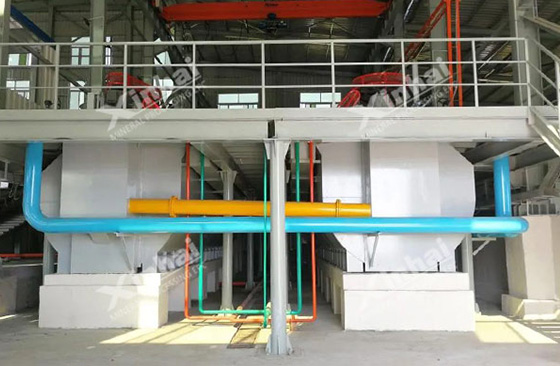
Iron tailings re-processing technology is one of the important methods for reusing iron tailings. Different types of iron tailings contain different types of valuable minerals, and the recycling methods used are also quite different. Common valuable minerals in iron tailings mainly include hematite, limonite, hematite, ilmenite, chalcopyrite, etc. Therefore, the separation process of iron tailings is mostly in compliance with the process, which can not only obtain a variety of valuable products, but also conform to the separation characteristics of minerals. The following mainly introduces you to the four re-processing technologies of iron tailings magnetic separation, gravity separation, roasting and flotation.
Iron tailings have finer particles and less strong magnetic minerals, so iron tailings reprocessing requires the use of high-gradient strong magnetic separation equipment. As mentioned before, the particle size of magnetic minerals in iron tailings is generally fine, and effective capture requires a very strong magnetic field. Therefore, a large number of ore particles with large gangue mineral content are often captured, resulting in a low enrichment ratio of the concentrate product. High gradient magnetic separation method is often used for pre-concentration of magnetic minerals, but is rarely used for the separation of iron concentrate products. The magnetic separation process is used in conjunction with gravity separation such as shaker process or centrifuge process to obtain iron concentrate and ilmenite concentrate.

(Shaker)
The gravity separation process can be divided into three types: spiral chute separation, shaker separation and centrifuge separation.
(1) Spiral chute: Spiral chute gravity separation is used for pre-disposal of iron tailings. The concentrate obtained by chute gravity separation will enter the regrinding system to increase the particle size of the target minerals to facilitate subsequent separation.
(2) Shaking table: used for re-selection of high-grade magnetic concentrates to obtain high-grade concentrate products. This process has a small processing capacity and is generally not used for direct separation of iron tailings. When shaking table sorting, it is necessary to control the particle size of the selected ore to obtain good sorting results. When a shaking table is used for gravity separation of fine-grained ores, the recovery rate of the concentrate will be reduced.
(3) Centrifuge: Used in conjunction with a strong magnetic separator, it can be used for the separation of fine-grained minerals. The concentrate recovery rate is high, but the enrichment ratio is low. Classifying plays an important role in the tailings re-processing process. Generally, it is necessary to set up classifying operations before re-processing, which can greatly improve the beneficiation index.
This process is mainly used for the recovery of weakly magnetic iron ores, such as hematite and hematite. During the process, the weakly magnetic iron oxide in the tailings is reduced to magnetite, or deeply reduced to elemental iron, and then this part of the iron mineral is recovered through a weak magnetic separation process. The roasting process can effectively recover weakly magnetic iron ore in iron tailings, but process control is difficult and the technical cost of deep reduction is high, so it is rarely used in actual production.

Flotation sulfide ore: used for desulfurization operations of iron tailings. When the sulfide ore contains valuable components, it can also be used as a means of pre-enrichment and separation.
Flotation desliming: mainly used for flotation of oxidized ores, such as apatite and mica, because amine collectors are often used in the flotation of oxidized ores, because amine collectors are sensitive to slime. If there is too much mud, flotation cannot proceed properly.
Reverse flotation: Mainly used for upgrading iron ore or ilmenite coarse concentrates. Amine collectors are commonly used to flotate silicate gangue minerals.
Minerals for flotation: Depending on the minerals for iron tailings, the flotation process and chemical system will be quite different. For example, fatty acids, soaps or mixed collectors are used to capture apatite, and selected the number of stages should not exceed four.
The above content is the re-processing technology of iron tailings. Iron tailings re-selection technology can design different re-processing processes according to different properties of iron tailings, thereby obtaining qualified concentrate products. The re-processing process can also recover valuable minerals in the tailings and make full use of the tailings resources. A reasonable iron tailings re-processing process can achieve large-scale production, which not only saves mineral resources but also creates economic value.
To find out more about our products and solutions, please fill out the form below and one of our experts will get back to you shortly.